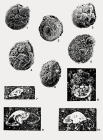Foraminifera taxon details
Rotorbinella mesogeensis (Tronchetti, 1981) †
1308859 (urn:lsid:marinespecies.org:taxname:1308859)
accepted
Species
Rotalia mesogeensis Tronchetti, 1981 † · unaccepted (Opinion of Boix et al. (2009) and...)
Opinion of Boix et al. (2009) and Piuz and Meister (2013)
marine, brackish, fresh, terrestrial
fossil only
(of Rotalia mesogeensis Tronchetti, 1981 †) Tronchetti, G. (1981). Les foraminifères crétacés de Provence (Aptien-Santonien) : systématique - biostratigraphie, paléoécologie, paléogéographie. <em>Travaux du Laboratoire de Géologie Historique et de Paléontologie Université de Provence (Marseille).</em> 12(1-3): 1-560. [details]
Description External view. Small rotaliid lacking any evident dimorphism of generations. The shell is asymmetrically lenticular, smooth...
Description External view. Small rotaliid lacking any evident dimorphism of generations. The shell is asymmetrically lenticular, smooth on both sides. The periphery varies from subacute to rounded, but it is always marked by an imperforate keel. The dorsal side is highly convex, while the ventral side can be convex or flat. The dorsal chamber walls are finely perforated. The pores of the ventral walls seem to be wider, and altogether lack in the foliar walls. There is a massive, free plug in the centre of the umbilicus. Internal characteristics. The chambers are arranged in a trochospiral that has three whorls in the adult test. The spire is loose and increases its step quickly. The number of isometric chambers in the last whorl is 8-10. The double septa vary from straight to slightly arched. They present intraseptal canals. The chamber lumen is divided by an umbilical plate in a main chamber lumen and a foliar chamberlet. These plates delimit a thin umbilico- spiral canal. No other canal system has been observed. In the axial section we observe a massive central plug separated from the proximal chamber walls by a deep spiral fissure. [details]
Hayward, B.W.; Le Coze, F.; Vachard, D.; Gross, O. (2024). World Foraminifera Database. Rotorbinella mesogeensis (Tronchetti, 1981) †. Accessed at: https://www.marinespecies.org/foraminifera/aphia.php?p=taxdetails&id=1308859 on 2024-10-17
Date
action
by
original description
(of Rotalia mesogeensis Tronchetti, 1981 †) Tronchetti, G. (1981). Les foraminifères crétacés de Provence (Aptien-Santonien) : systématique - biostratigraphie, paléoécologie, paléogéographie. <em>Travaux du Laboratoire de Géologie Historique et de Paléontologie Université de Provence (Marseille).</em> 12(1-3): 1-560. [details]
basis of record Tronchetti, G. (1993). Rotalia mesogeensis Tronchetti, 1981 (Foraminiferida) : importance biostratigraphique, paléoécologique et paléobiogéographique pour le Cénomanien téthysien. <em>Géologie Méditerranéenne, 20-1, pp. 45-51.</em> , available online at https://www.persee.fr/doc/geolm_0397-2844_1993_num_20_1_1484 [details]
additional source Piuz, A.; Meister, C. (2013). Cenomanian rotaliids (Foraminiferida) from Oman and Morocco. <em>Swiss Journal of Palaeontology.</em> 132(2): 81-97., available online at https://doi.org/10.1007/s13358-013-0054-2 [details] Available for editors [request]
[request]
new combination reference Boix, C.; Villalonga, R.; Caus, E.; Hottinger, L. (2009). Late Cretaceous rotaliids (Foraminiferida) from the Western Tethys. <em>Neues Jahrbuch für Geologie und Paläontologie - Abhandlungen.</em> 253(2): 197-227., available online at https://www.researchgate.net/publication/233570490_Late_Cretaceous_rotaliids_Foraminiferida_from_the_Western_Tethys [details] Available for editors [request]
[request]
basis of record Tronchetti, G. (1993). Rotalia mesogeensis Tronchetti, 1981 (Foraminiferida) : importance biostratigraphique, paléoécologique et paléobiogéographique pour le Cénomanien téthysien. <em>Géologie Méditerranéenne, 20-1, pp. 45-51.</em> , available online at https://www.persee.fr/doc/geolm_0397-2844_1993_num_20_1_1484 [details]
additional source Piuz, A.; Meister, C. (2013). Cenomanian rotaliids (Foraminiferida) from Oman and Morocco. <em>Swiss Journal of Palaeontology.</em> 132(2): 81-97., available online at https://doi.org/10.1007/s13358-013-0054-2 [details] Available for editors
new combination reference Boix, C.; Villalonga, R.; Caus, E.; Hottinger, L. (2009). Late Cretaceous rotaliids (Foraminiferida) from the Western Tethys. <em>Neues Jahrbuch für Geologie und Paläontologie - Abhandlungen.</em> 253(2): 197-227., available online at https://www.researchgate.net/publication/233570490_Late_Cretaceous_rotaliids_Foraminiferida_from_the_Western_Tethys [details] Available for editors
From editor or global species database
Description External view. Small rotaliid lacking any evident dimorphism of generations. The shell is asymmetrically lenticular, smooth on both sides. The periphery varies from subacute to rounded, but it is always marked by an imperforate keel. The dorsal side is highly convex, while the ventral side can be convex or flat. The dorsal chamber walls are finely perforated. The pores of the ventral walls seem to be wider, and altogether lack in the foliar walls. There is a massive, free plug in the centre of the umbilicus. Internal characteristics. The chambers are arranged in a trochospiral that has three whorls in the adult test. The spire is loose and increases its step quickly. The number of isometric chambers in the last whorl is 8-10. The double septa vary from straight to slightly arched. They present intraseptal canals. The chamber lumen is divided by an umbilical plate in a main chamber lumen and a foliar chamberlet. These plates delimit a thin umbilico- spiral canal. No other canal system has been observed. In the axial section we observe a massive central plug separated from the proximal chamber walls by a deep spiral fissure. [details]

